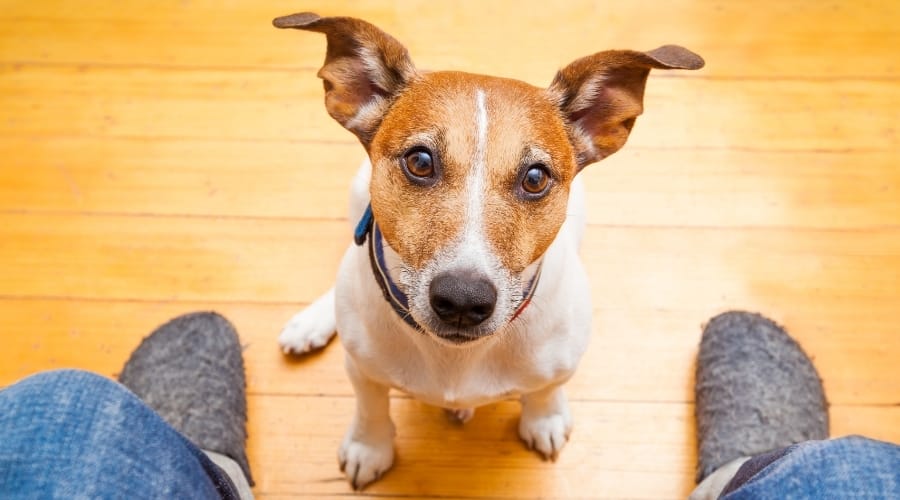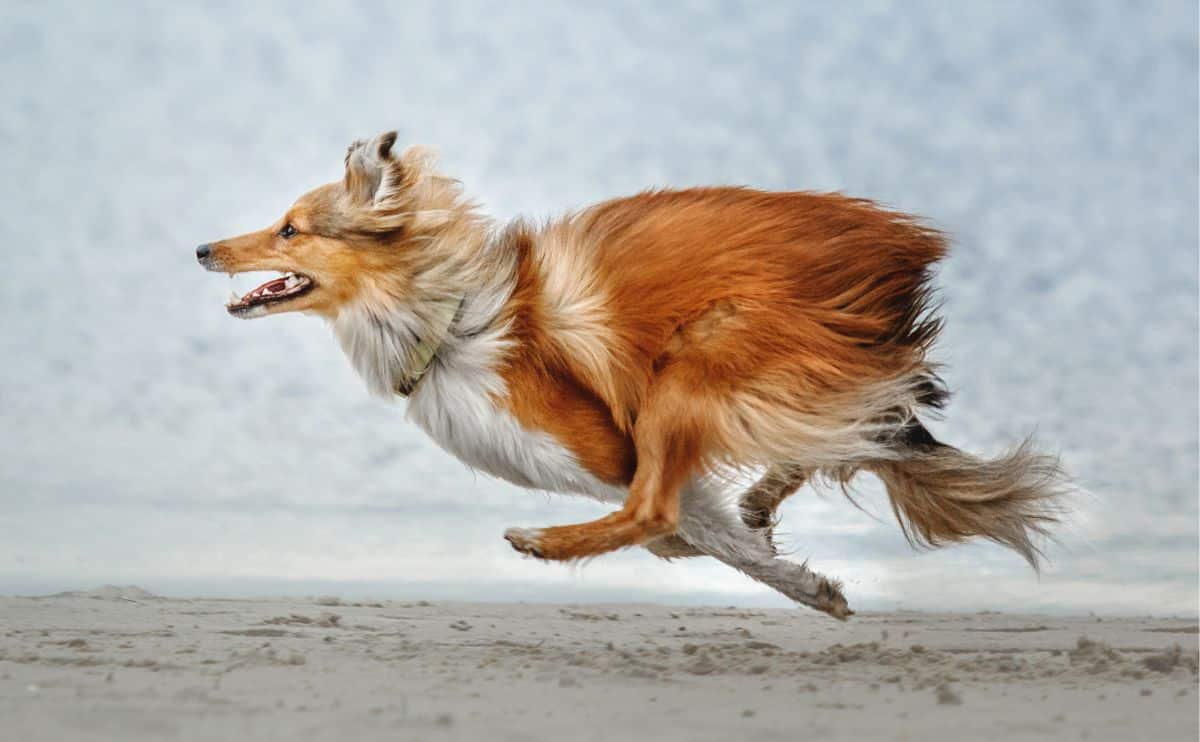Why Do Dogs Sit, Sleep, Or Lay on Your Feet? Here Are 8 Reasons, And You Won’t Believe #6!
When you purchase through links on our site, we may earn a commission. Here’s how it works.
Ever feel like your dog’s treating your feet like a heated throne? One minute you’re standing, the next you’re stuck, a hostage to 60 furry pounds of “affection.” But here’s the twist: when your dog sits on your feet, it’s not just a cozy cuddle move.
Table of Contents
They might be keeping tabs on you, claiming you as their territory, or signaling something way deeper (and funnier) than you’d expect. Let’s break down what your foot-sitting floof is really up to, and whether you should be flattered… or mildly concerned.
Why Do Dogs Sit (or Lie) On Your Feet? 8 Reasons
Your dog plops down on your feet like it’s their full-time job, but why? Spoiler: it’s not because they think your Crocs are comfy. Is it love? Comfort? Possessiveness? All of the above?
Turns out, this fuzzy little foot-sitting habit can reveal a lot about your dog’s instincts, emotions, and behavior, and not all of them are harmless.
In some cases, it’s totally fine (even flattering). But in others, it might be a sign of stress, anxiety, or guarding behavior you shouldn’t ignore.

Here are eight reasons your dog might be sitting, lying, or sleeping on your feet:
- They love you (adorable, right?)
- They’re just cold, and your feet are free heating pads
- It’s instinct from their pack-animal roots
- Being close makes them feel safer
- They’re marking you as “theirs”
- They think they’re in charge (don’t panic… yet)
- They’re guarding you from threats (real or imagined)
- They want to track your every move like a furry little spy
Some of these are heartwarming. Others might mean it’s time to set a boundary or talk to a trainer. I’m breaking them all down, fast, funny, and fluff-friendly, so you’ll know exactly what your dog is trying to tell you (and whether to be flattered or mildly alarmed).
👇 Keep scrolling, because your feet deserve answers.
1. It’s Instinct – You’re Part Of Their Pack
Before dogs were your couch-loving cuddle monsters, they were wild pack animals. Even 5-pound Chihuahuas, who have never spent a day in the wild, are still domesticated from their wild ancestors.
Sitting or lying on another pack member helped maintain warmth, trust, and safety. It’s an age-old survival behavior that still plays out on your living room floor.
When your dog sits on your feet today, they might just be tapping into that ancient instinct: “Stick close. Stay safe. This human = home.” It’s not a thought-out choice; they’re just following internal programming.
- They see you as part of their pack
- Physical closeness reinforces their connection to you
- It’s hardwired behavior they’ve carried from puppyhood
Since you are the alpha, they must lie at your feet once you’ve found your comfortable spot. This act basically tells you that they respect you as their leader of the pack and want to lie at your feet as a sign of that.
Puppies often pile up when they sleep. Adult dogs just swap littermates for human legs.
2. They Love You & Want To Be Close
Your dog isn’t just being cute when they plop down on your feet like a fuzzy paperweight. They’re sending a message, and sometimes that message is simply, “I love you. Please never leave.”
In the animal kingdom, physical closeness often equates to emotional bonding. Dogs use body contact to show trust and loyalty. If your pup is choosing your feet over the rest of the house, you’re doing something right.
- You’re their safe space
- They trust you completely
- They want a constant connection, even if it means squishing your toes
Some dogs will follow you room to room, then flop down on your feet as if to say, “Don’t leave. Ever.”

Plus, by lying on top of your feet, they know that they will be the first to know when you decide to switch positions or get up to leave the room. Knowing that they are aware of their owner’s location at all times can be comforting to a devoted companion.
3. You’re Basically A Heated Seat
Dogs are heat-seeking missiles in fur coats. Your feet? They’re the perfect combo of warm, stationary, and accessible. To your dog, sitting on your feet is like hitting the comfort jackpot. Bonus points if it’s chilly outside.
- Cold house? You’re the cozy spot
- Lying on your feet keeps them toasty
- Your scent and warmth = ultimate comfort combo
This is especially common in smaller breeds that get cold easily. If they always gravitate to your feet when the temperature drops, they’re not just being clingy; they’re being smart. So, if your dog is a toe-hugger in winter, now you know why.
Yes, your dog probably loves you. But when they sit on your feet, that cozy gesture might have less to do with undying loyalty… and more to do with your body heat.
Do you think this is the reason for your dog’s feet-sitting behavior? If so, check out our DIY dog sweater guide with free knitting patterns to keep your pup warm. Or print it off for Grandma.
4. They Feel Safer When They’re Touching You
Since our furry companions see us as their pack leaders, we are essentially their superheroes. They trust us to take care of them and have faith that we will protect them when needed.
Being close to you lowers your dog’s stress. When they sit on your feet, it can mean they’re feeling uncertain, and you help them regulate their emotions. Think of yourself as their emotional anchor during moments of overwhelm.
This behavior can spike during fireworks, thunderstorms, unfamiliar environments, or visits from strangers. You may notice your dog press up against you, curl into your legs, or rest their weight squarely on your feet as a form of self-soothing.
- New environment? They anchor to you.
- Loud noises or strangers? You = comfort zone
- You’re their built-in anxiety blanket
A gentle touch from you can calm their nerves faster than any toy or treat.

A Vet’s Take: Is It Really Just Love?
While some dogs may be staking their claim or simply seeking warmth, many are expressing something deeper: an emotional attachment. According to Dr. Amber LaRock, a licensed veterinarian, this kind of closeness isn’t random. It’s rooted in how dogs form bonds with their humans.
Over the years, dogs have become intertwined with their human companions. Studies have shown that dogs tend to display a ‘secure base effect,’ which is similar to what is found in parent-child bonding. This means that like a child clinging to a parent, dogs seek our presence for comfort.
– Dr. Amber LaRock, DVM, Veterinarian Contributor to Canine Journal
So yes, sitting on your feet might be cozy, protective, or mildly clingy… But at the heart of it? It’s often just your dog’s way of saying, “You’re my safe place.”
5. They’re Marking You As Theirs
Some dogs use body contact as a subtle claim: “This human is mine.” Foot-sitting can be their low-key way of marking territory without peeing on your carpet. Dogs have scent glands in their paws, so contact is one way they “label” their people.
You may notice this more around other pets, new visitors, or unfamiliar dogs. They’re not just chilling, they’re claiming their spot.
- Spreading their scent = leaving a personal tag
- Sitting between you and someone else? That’s no accident
- It’s a mix of affection and mild possessiveness
It’s cute until they growl when someone else approaches…
6. They Think They’re In Charge
Let’s talk dog drama. When your pup plants themselves on your feet and gives side-eye to your guests, it could be a power move. While foot-sitting often means love or comfort, in some dogs, it crosses into territory management or social ranking.
This doesn’t mean your dog is trying to overthrow your household, but it could be a sign of a dominant personality testing the limits. If they’re stiff, controlling access to you, or acting territorial, that’s a behavior to watch.
- Some dogs sit to assert subtle dominance
- It’s not aggressive, just… mildly controlling
- Especially if they refuse to move or block others from you
If they sit like royalty but act like security, it’s time to set a few boundaries.
7. They’re Guarding You From Threats (Real or Imagined)
Foot-sitting can be part of protective behavior. If they’re tense, alert, and always watching the door, they might be acting as your self-appointed bodyguard. This is especially common in protective or working breeds.
While this behavior can feel sweet (aww, my dog’s protecting me!), it can easily shift into over-guarding, which can become a problem.
- Common in protective or high-alert breeds
- They’re ready to react to anything they see as danger
- Even if the “danger” is a leaf, an Amazon driver, or your date
But let’s be clear, not all guarding is bad. Some signs it’s harmless:
- They sit calmly but alert
- No growling or stiff posture
- They move when you ask (eventually)
Warning signs it’s time for training:
- Low growls at others near you
- Hovering between you and a guest
- Tense body, frozen stare, like a bouncer outside a club
Our dogs can love us to the point of getting themselves into some risky situations!
We have a comprehensive guide on training tips for aggressive dogs, which you’ll want to check out if you suspect your dog is acting more than just clingy.
8. They Can’t Handle Being Away From You
If your dog’s sitting on your feet, following you to the bathroom, and staring at you while you brush your teeth like you’re Beyoncé, we need to talk about clinginess.

This kind of constant proximity can be sweet, but also exhausting for both you and your pup if not managed. Without intervention, it can lead to destructive behavior, barking, or panic when you’re gone.
- Some dogs need to touch you to feel okay
- Sitting on your feet = anchoring behavior
- Often, the first sign of clingy tendencies that could escalate
Signs that it’s separation anxiety and more than just affection:
- Pacing or whining when you move
- Panic when you leave the house (even for five minutes)
- Sitting on your feet and refusing to budge like a weighted blanket with opinions
This isn’t about dominance, it’s about insecurity. Your dog’s saying, “If I sit on you, you can’t leave. It’s science.” Constant foot-sitting, pacing, whining, or panic when you leave indicates that you need to consult with your vet or a dog trainer.
We’ve got plenty of guides to help with dog training, including a roundup of the best dog training apps and dog training courses to get started.
So, Are They Claiming You Or Just Being Clingy?
Let’s talk dog drama. When your pup parks their butt on your feet, it might not be all cuddles and cozy vibes; it could be their way of saying, “This human is mine. Back off.”
Some dogs use body contact as a low-key dominance move. It’s not aggressive, just… slightly possessive, like when someone “accidentally” takes up your whole side of the couch and calls it bonding.
Here’s how to tell the difference:
| Clingy Love | Claiming You |
|---|---|
| Relaxed body, happy face | Tense posture, alert eyes |
| Follows you everywhere | Blocks others from approaching |
| Sits on you gently | Plops down like they own you |
If your dog gets stiff or growls when someone comes near you, it’s a red flag, and not the cuddly kind. That’s more about control than affection, and it may be time to chat with a trainer.
Quick Tip: If your dog acts like you’re a VIP lounge they’re guarding, try redirecting them to a dog bed or blanket when guests are around.
Should You Let Them Keep Doing This?
So… should you let your dog treat your feet like a mattress with a pulse? In most cases: absolutely. It’s adorable, harmless, and honestly? Kinda flattering.
But there are situations where the habit needs a gentle redirect, especially if it’s turning into clingy chaos or power plays. If your pup shows any type of aggression, or you simply don’t want your dog under your feet at every moment of the day, there are a few ways to stop this behavior.
When It’s Totally Fine
- They’re calm, affectionate, and move when asked
- No signs of guarding, growling, or anxiety
- You’re into it (let’s be real, some of us love it)
When You Might Want To Intervene
- Growling or guarding behavior
- They get distressed when you move
- You’re one foot-nap away from tripping over them
You’re not being mean by setting boundaries. Even clingy fluffballs need emotional independence.
Vet Wisdom on This Weird Dog Habit
While there are plenty of theories about why dogs love sitting on our feet, I asked Dr. Amber LaRock, a licensed veterinarian with years of experience in animal behavior, what she thinks about why dogs sit on our feet.
Overall, this is an endearing action. If there was a way for our pups to show us just how much they love us, it would very well be done while sitting on top of our feet. By laying or sitting on us, they are telling us how good of a job we are doing at being their pack leader.
Unless this action is accompanied by any undesirable actions, it is a perfectly normal way for our dogs to show us that they care.
– Dr. Amber LaRock, DVM, Veterinarian Contributor to Canine Journal
4 Easy Ways To Stop the Foot-Sitting Habit
If your dog sitting on your feet is cute but also clingy, or maybe starting to feel a little possessive, it’s okay to set some boundaries. The good news? You can redirect the behavior without hurting their feelings or their ego (yes, dogs have egos; have you ever tried moving one off your pillow?).
Here’s how to gently teach them that your feet are not a dog bed:
1. Don’t Reinforce The Behavior In The Moment
This one’s tricky, because it’s instinct to reach down and pet your dog when they’re curled up on your toes. But when you do that, you’re basically saying, “Good job sitting on me. Please do it again.”
Instead, try not to give them attention while they’re on your feet. No petting, no sweet talk, no eye contact. You’re not being mean, you’re just not rewarding the behavior.
2. Teach a “Place” Command
This is your secret weapon. Get a cozy dog bed or blanket and keep it near you, but not under you. Use a cue like “place” or “bed” and reward them when they go there instead of your feet.
Start small:
- Guide them to the bed
- Reward with treats or praise
- Repeat consistently until they get it
Over time, they’ll associate their space with good stuff, and your feet can breathe again.
Want to teach your dog the “place” command and give your feet a break? Watch this quick training video that shows exactly how to guide your pup to their bed, without the drama.
3. Reward The Behavior You Want
When they choose to sit next to you instead of on you? Jackpot moment. Give them praise, treats, belly rubs, whatever motivates them most.
By making the “off-feet” behavior more rewarding than the “on-feet” habit, you’re flipping the script without scolding.
4. What If It’s Aggression Or Anxiety?
If your dog growls, guards, or gets tense when someone comes near while they’re sitting on your feet, this isn’t just a habit. It’s a red flag.
In these cases, don’t try to fix it alone. Reach out to a certified dog trainer or behaviorist for guidance. They’ll help you work through:
- Resource guarding
- Separation anxiety
- Dominance-driven reactivity
Professional help ensures you’re not just managing the symptoms, but solving the root issue, safely and effectively. Training doesn’t mean pushing your dog away or punishing them. It’s about guiding them toward better habits, with lots of love, structure, and yes, snacks.
You could also try an online dog trainer, such as Doggy Dan, for an affordable solution that fits your schedule.
Our Personal Experience With Our Dog Sitting On Our Feet
I asked a few members of the Canine Journal team if their dogs do this too, and surprise, we’re not alone. Turns out, foot-sitting is a common (and oddly emotional) habit for plenty of our pups. Here’s one personal experience that stood out:
My dog Daisy, A Labrador Pitbull mix, is my personal feet warmer. She loves to be near me, but at 85 pounds, she isn’t exactly a lap dog. So Daisy is what we call a foot dog. She has always been like this. Even as a puppy, she had a thing for feet.
She curls up at my feet under my desk, when I’m sitting on the couch and even when I am in bed. She doesn’ t lay on the bed but sleeps on the floor, as close to my feet as she can get. Daisy will even sit by my feet when cooking! We live in a cold climate, so I don’t mind the help keeping my toes warm.
Daisy is pretty attached too. If I sit in a way she can’t reach my feet she will paw at me or push her nose into my hand until I move. It’s almost like it’s her house, not mine.
– Danielle DeGroot, Rescue Dog Mom & Writer for Canine Journal

Photo by Danielle DeGroot for Canine Journal, © Cover Story Media, Inc. 2024
FAQs About Dogs Sitting on Your Feet
Got questions about your dog’s foot-sitting obsession? You’re not alone. Here are some quick answers to the most common questions I hear. If yours isn’t listed, feel free to add it in the comments! We’re always happy to dig into more weird (but lovable) dog behavior and answer our readers’ questions.
Is It Normal for Dogs to Sit on Your Feet?
Totally normal. In most cases, it’s a mix of affection, instinct, and habit. Some dogs just want to stay close to their humans, and your feet happen to be right there. Warm, loyal, convenient. You’re basically a deluxe footrest.
Should I Be Worried If My Dog Won’t Stop Sitting on My Feet?
Only if it comes with other red flags, like growling, blocking others from getting close, or signs of separation anxiety. Look out for body language. If it’s just cuddly and cute, you’re fine. If it feels more like guarding or obsessing, it might be time to check in with a trainer.
Is My Dog Trying to Dominate Me by Sitting on My Feet?
Maybe, but not always. Some dogs use sitting as a mild dominance move, especially if they get stiff or possessive. But for most dogs, it’s just comfort or closeness. Watch for context: are they chill, or are they acting like your personal bodyguard?
How Can I Train My Dog to Stop Doing It?
Teach a “place” command, reward them for sitting beside you (instead of on you), and avoid petting them when they’re mid-foot-squat. Don’t punish. Just guide them toward better habits, and reward the good stuff.
Is It Okay to Let Them Keep Doing It?
If you like it, and your dog isn’t acting possessively or anxiously? Sure! It’s a sweet bonding moment. Just know your boundaries, literally. You deserve foot freedom when you want it.
Other Weird Dog Habits We’re (Kinda) Obsessed With
If sitting on your feet isn’t the weirdest thing your dog does, don’t worry, they’re just getting started. There’s the intense eye contact they make while pooping, like they’re daring you to look away during their most vulnerable moment.
Or the way they obsessively sniff your friend’s crutches like it’s some kind of sacred relic. Then there’s poop-eating (yep, I said it), a gross but strangely common habit with more science behind it than you’d think.
And of course, the 9 p.m. zoomies, that sudden explosion of chaotic energy that turns your living room into a canine NASCAR track. Dogs are weird. Wonderfully, hilariously, sometimes-disgustingly weird. And we’re here for it.
Got a Foot-Sitter at Home? We want to hear about it! Does your dog sit on your feet every morning? Every time you stop moving? Do they give you the stink-eye if you try to leave? Share your funniest, weirdest, or sweetest foot-sitting stories in the comments, because we’re all ears (and paws).



